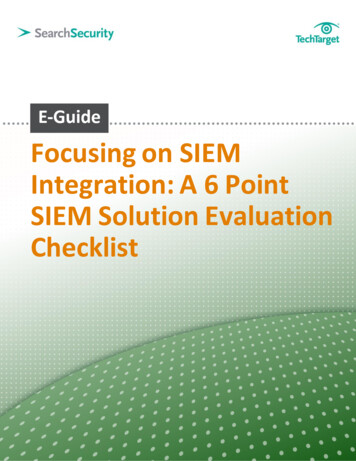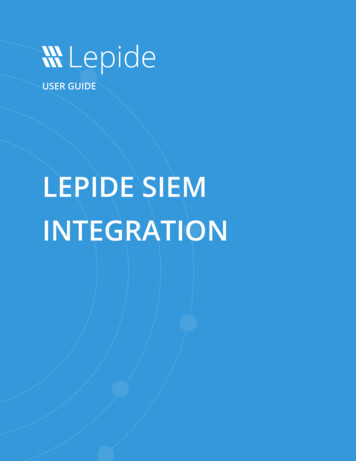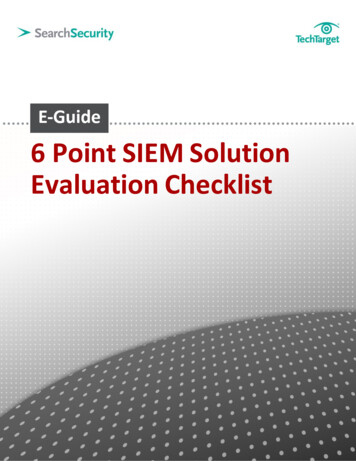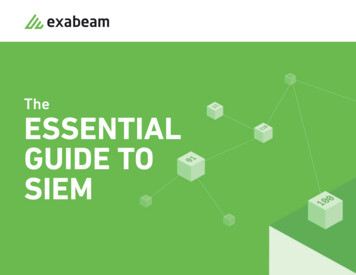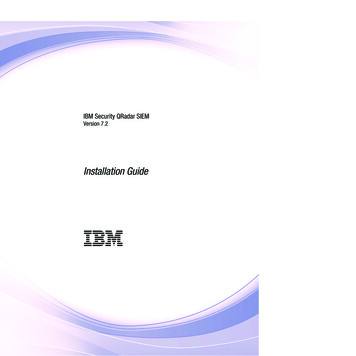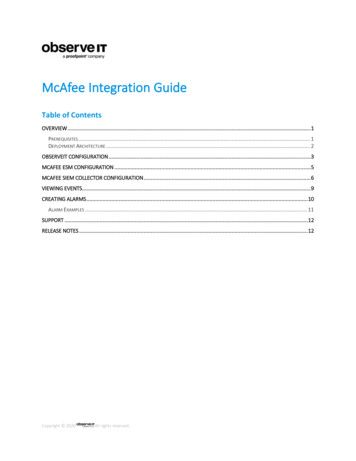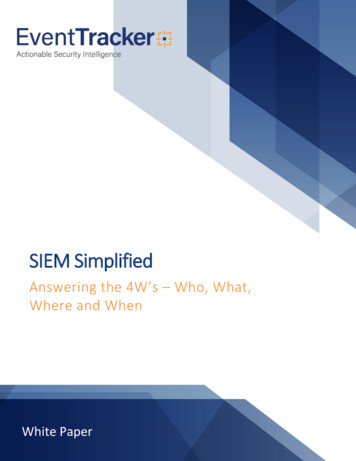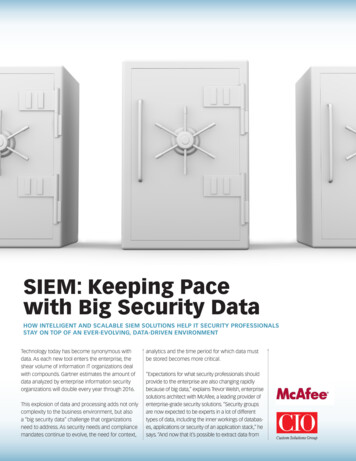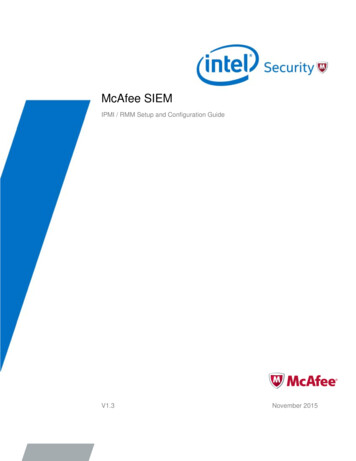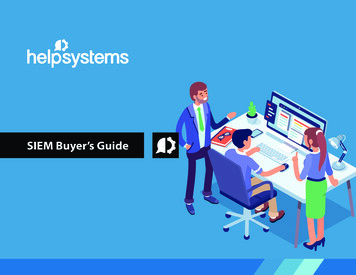
Transcription
SIEM Buyer’s Guide
SIEM Buyer’s GuideSIEM Buyer’s GuideThe Security Challenge TodayIt’s no secret that security threats are increasing, andthey can come from both internal and external sources.In addition to ongoing threats from hackers looking tobreach the security protocols guarding your sensitiveinformation, another rapidly rising concern is that ofemployees who accidentally misconfigure securitysettings in a way that essentially opens the door to attack.To address these issues, IT organizations have put varioussystems in place to protect against intrusion and a host ofdifferent risks.The downside of these safeguards is they generate somuch monitoring data that IT teams are then facedwith the problem of interpreting it all to pinpoint actualproblems. In fact, the volume of security data flowing tounderstaffed IT security groups is largely useless unlessit can be quickly analyzed and filtered into actionablealerts. Given the reams of data in question, it’s no longerpossible for organizations to use manual analysis tohandle this job.This is where SIEM software steps in.www.helpsystems.com2
SIEM Buyer’s GuideIntro to SIEMSIEM—or security information and event management—is a type of software that aims to give organizations helpful insights into potential security threatsacross critical business networks. This is possible via centralized collection and analysis of normalized security data pulled from a variety of systems, includinganti-virus applications, firewalls, and intrusion prevention solutions.Gartner coined the term ‘SIEM’ (pronounced “sim”) in a 2005 report called “Improve IT Security With Vulnerability Management.” The term brings together theconcepts of security event management (SEM) with security information management (SIM) to achieve the best of both worlds. SEM covers the monitoring andcorrelating of events in real time as well as alerting the configuration and console views related to these activities. SIM takes this data to the next phase, whichincludes storage, analysis, and reporting of the findings.Why Is SIEM Important to Companies Today?With SIEM, you have an effective method of automating processes and centralizing security management in a way that helps you simplify the difficult taskof protecting sensitive data. SIEM gives you a leg up in understanding the difference between a low-risk threat and one that could be detrimental to yourbusiness.SIEM software relays actionable intelligence that enables you to manage potential vulnerabilities proactively based on real-time information, protecting yourbusiness and your customers from devastating data breaches. With the ever-increasing incidence of these attacks, this technology is more important than ever.Sharpen Your ViewSIEM is an essential part of your security and IT toolkit today. Think of it as a lens that sharpens your view across the big picture to help you focus your team’sefforts on where they can have the most impact. This is particularly important in situations involving emerging threats, when the ability to collect and analyzeincoming data aids in how quickly analysts can investigate and resolve issues.Summary of Key SIEM CapabilitiesCentralize your view of potential threatsDetermine which threats require remediation, and which events are simply noiseEscalate issues to the appropriate security analysts who can take fast actionInclude context for security events to enable well-informed fixesDocument detected events and how they were remedied in an audit trailShow compliance with key industry regulations in an easy reporting formatwww.helpsystems.com3
SIEM Buyer’s GuideHow Has SIEM Advanced Overthe Years? Integration with other security tools: SIEM pulls in data from antivirusapplications, login data, security auditing software and more to give youa holistic picture of your environment. Forensic data: SIEM gives you the ability to drill into the details ofa security incident to determine exactly what happened and whatequipment may have been affected. Audit trial: Meeting compliance requirements requires the ability togenerate a detailed audit trail of your security practices and events, andSIEM enables this with detailed reporting. Normalized data: Having security data flowing into a centralized viewof your infrastructure is effective only when that data can be normalized.This means that despite thousands or millions of inputs coming fromdifferent systems and sources, everything can be put into a commonformat ready for the SIEM solution to conduct its analysis and correlation.This takes the workload off your team and enables them to leverage astreamlined view of activity and potential concerns. Correlation: Oftentimes, correlating individual records or events (e.g., alogin that was just created and then used to access sensitive information)enables you to clarify the bigger picture and identify malicious activitiesas they happen.www.helpsystems.com4
SIEM Buyer’s GuideKey Features in an Effective SIEM SolutionGiven the number of SIEM solutions on the market today and the capabilities described previously, it’s helpful to understand the features youneed to support your efforts. Consider these areas as you evaluate your options.Security Event PrioritizationStreamlined Incident ResponseIt is impossible to stay ahead of the curve if your security team is buriedinvestigating meaningless security events. You need to determine whichevents are most critical and which are lower priority. Look for a solution thatmakes the prioritization process easy with out-of-the-box controls that can beadjusted as you see fit.Automatically escalate events to the right person and manage any cases thatrequire further investigation to make your team more efficient.Normalization of Disparate Data SourcesOrganizations rely on multiple technologies to run their business. Thismakes it difficult for security teams to understand the data coming in fromthese disparate sources. SIEM turns this data into actionable intelligenceby normalizing it into a common format and giving it meaning. With arobust solution, analysts won’t need to understand the nuances of differentoperating systems, applications, databases, firewalls, or network appliances toknow what the data means and what to do with it.Data EnrichmentLook for the ability to get additional context behind security events forquick and thorough response. Data enrichment puts all the necessary eventdetails and forensic analysis at your fingertips. For example, if a new user iscreated and then that user immediately connects to a critical system, SIEMcan recognize that this is not normal behavior and escalate the incident forinvestigation.Real-Time Threat DetectionOut-of-the-Box SecurityAs you connect new data sources, like Windows servers or Oracle databases,make sure you can automatically apply the appropriate security controls andescalation rules. Out-of-the-box security templates make it easy to get startedquickly and can be configured as needed.Security and Compliance ReportingIT operations and security teams alike are required to provide reports toboth auditors and executives on a regular basis. Most organizations alsoneed to comply with multiple regulations, which adds to the complexity andreporting effort. Having a robust reporting engine in your SIEM provides foreasy reporting of log data, events, and incident response activity. Compliancereports generated by a SIEM can even help show you how your securityposture is improving over time.The Bottom Line on FeaturesInvest in a solution that has the right level of features to meet your needs—but isn’t so complex your team won’t be able to use it easily on a daily basis.You don’t want to get stuck with a tool that’s complicated or expensivebecause it will likely prevent you from implementing other critical controls inyour organization.In order to minimize the impact of a breach, you have to detect threatsquickly. This means having the ability to log, correlate, and prioritize events inreal time to give your team a head start on resolving and mitigating threatsbefore they result in a devastating breach.www.helpsystems.com5
SIEM Buyer’s GuideAdditional Areas to EvaluateAside from functionality considerations, there are other elements of your SIEM solution that will determine its long-term success and usabilityfor your organization.Enterprise Solutions vs. Open SourceSome SIEM solutions fall into the enterprise category, meaning they have adedicated development team focused on product enhancements as well ascustomer support. Other options are built on the open source model andrely on a large community of developers for support and bug fixes. Opensource SIEM solutions provide basic functionality that can be great for smallerorganizations that are just beginning to log and analyze their security eventdata. But over time, many IT professionals find that open source SIEM softwareis too labor-intensive to be a viable option as the organization grows. Inaddition, some companies have policies that discourage the implementationof open source solutions, so make sure you know the pros and cons of eachapproach and what’s allowable at your organization.AutomationSome parts of the SIEM process can be automated to save time and speedinformation sharing among your team. Notifications can also be routed tothe right person depending on the event/data source. For example, a virusdetection event coming from your Linux environment can be directly routedto your Linux admin, who will know best how to quickly isolate the systemand remediate the infection before it spreads across the environment.Professional services usually provide integration, development, andconsulting. If you don’t have the resources needed to implement the solution,or you’d like to have the vendor help with the migration to the new solution,be sure to ask whether these services are available.Training should give you in-depth knowledge of the solution. When yourequest details on the training, consider asking the vendor the followingquestions: Are the training costs the same regardless of how many people attendthe session? Is the training interactive or demonstrated by the trainer? Are there course outlines you can review before purchasing the sessions? Can you customize what will be covered in training?SupportEvaluate the vendor’s customer support options. Are they offered 24/7? Canyou communicate issues via web, phone, and chat? Is support outsourced orhandled locally? All of these considerations are important to think through toprotect the long-term health and relevance of your SIEM application.Implementation and TrainingIntegrationsEvery software vendor has a different process when it comes to how theirsolutions are implemented and the ways your team can participate in training.Understanding your options for these services is key to getting a handleon how long it will take to get up and running on the software and whenyou can realistically start seeing the benefits. Intuitive solutions require aminimal amount of upfront training to start seeing results that will benefityour organization. More complicated solutions require your team to invest asubstantial amount of time in training and regular system tuning activities.Having a complex composition of disparate security solutions can make itchallenging to effectively ensure the safety of your environment. Integrationsbetween products like antivirus or security auditing software enhanceefficiency by allowing for seamless transitions between products to create amore streamlined, centralized security profile. This helps you assess potentialimpacts to the security of information stored on-premises, in the cloud, or in ahybrid configuration.www.helpsystems.com6
SIEM Buyer’s GuideOther Cost ConsiderationsLicensing and Deployment MethodsImpact on HeadcountSome SIEM software vendors charge by the amount of data generated or byhow many systems the solution is managing, and others simply have a flat-rateapproach. Likewise, deployment models can be on-premises or in the cloud, andsome solutions use agents while others don’t. An agent is code that has to beplaced between endpoints/systems to enable the sending of information from thesystem being monitored to the SIEM solution for normalization and evaluation.Agentless applications connect automatically to the systems they monitor tosimplify administration. Find out how differences in the offerings you evaluate mayaffect your overall total cost of ownership.Some solutions require dedicated staff to run the software and manage theinterface of events. Others are a little more lightweight and can likely bemanaged by your existing staff. Determine whether the new SIEM applicationwill require additional headcount for day-to-day management, and whetherthis cost is in your existing budget.ROIBeing able to detect threats and shut them down will have significant ROI for yourbusiness, but it could be hard to quantify. Focus on the efficiency the SIEM solutionis bringing to your IT organization and the time it’s saving as an aggregator ofmultiple sources of security information. You can evaluate how the SIEM solutionhelps you:Centralize your view of potential threatsDetermine which threats require remediation, and which events are simply noiseEscalate issues to the appropriate security analysts who can take fast actionSIEM’s Role in Regulatory ComplianceSIEM gained popularity with large businesses working to comply with thePayment Card Industry Data Security Standard (PCI DSS). In addition, it hashighly useful applications in helping you meet regulations for the EU’s GeneralData Protection Regulation (GDPR), Sarbanes-Oxley (SOX), and others. Theselaws require organizations to have mechanisms in place to detect threatsand resolve them quickly. This means you have to know what’s happeningin a wide-reaching IT infrastructure that could span on-premises, cloud, andhybrid environments.A SIEM solution is key to getting the right kind of insight in place to monitordata and act quickly for threats determined to be cause for alarm. Whenall this activity is captured in a detailed audit rail, auditors can see yourorganization is taking the necessary steps to protect its data.Include context for security events to enable well-informed fixesDocument detected events and how they were remedied in an audit trailShow compliance with key industry regulations in an easy reporting formatwww.helpsystems.com7
SIEM Buyer’s GuideRequirements ChecklistAfter you’ve thought through the features and other options you’ll need in your SIEM solution, it’s helpful to develop a requirements checklist to evaluatethe various offerings on the market and how they line up with what you need.Below is an example checklist to help you get started.RequirementVendor 1Vendor 2Vendor 3The solution has role-based access controls for separation of dutiesThe security regulations I need, such as (e.g., PCI DSS, HIPAA, SOX, BCRA, FISMA), are supported by the solution.The solution collects logs and events from multiple sources and system types I require, such as (e.g., Linux, AIX, Windows, IBM i, VMware, networkappliances, databases).The solution correlates security events in real time.The solution stores historical data over the long term to support compliance mandates.The solution works for multiple use cases, including non-security projects such as IT operations.It’s easy to operate and doesn’t require complex programming or specially skilled staff.The solution is scalable with predictable pricing.The solution is backed by a proven company with a history of providing robust software and making further investments and improvements.The solution isn’t limited to being installed only on-premise; security practitioners must support hybrid and cloud-first models.There’s an open ecosystem that enables user configurations to support their unique use cases.The dashboard supports data sorting and filtering with a few simple mouse clicks.There’s built-in reporting with configurable report templates.The solution features a full audit trail of security analyst activities.The solution monitors user activity to pinpoint breach attempts and uncover misuse.The solution automatically prioritizes threat events and assigns them to analysts.The solution supports the ingestion of application logs and events via simple menu interfaces.The solution can identify notable events, indicate their severity, and display their status.The solution can perform ad-hoc searches of event and log data.The solution translates data from multiple sources into a common format for easy analysis.The solution integrates with other security tools like antivirus or security auditing software.www.helpsystems.com8
SIEM Buyer’s GuideYou Have Your Short List of Vendors—Now What?Determine Your BudgetWhen determining how much you want to spend on a SIEM solution, consider what is—and isn’t—included in the price. Questions to ask the vendor’ssale team include: Can I license specific modules? Can I lease the software? Do you offer user- or vendor-based licensing, or are users and vendors unlimited?Beyond initial software licenses, most buyers purchase a support package and annual maintenance, so they can upgrade to the latest product versionas soon as it’s available. Also consider any optional investments you’d like to put into the product, such as professional services (e.g., migration andimplementation assistance, software training) or add-on modules that expand what you can do with your SIEM solution.Study Vendor ResourcesTake some time to explore each vendor’s SIEM resources. Good resources, like online documentation and educational videos, tell you that a vendor isnot only dedicated to developing powerful software, but that they’re also dedicated to helping you understand everything the product can do for yourorganization.Request a DemoAfter you’ve whittled down the options to two or three that look like they will fit your organization’s needs, invite stakeholders who are part of thepurchase decision to live, one-on-one demos. These typically last an hour and are run by each vendor’s SIEM product experts.Come prepared and ask the questions that will help you fully evaluate each solution and address any concerns you have. During each demo, rememberyou’re evaluating not only the software, but also the vendor’s representatives and their professionalism. As they’ll be your partner for SIEM functionalityfor years to come, you need to feel confident in their capabilities.Trial the SolutionFor the solution that truly piques your interest, determine whether you want to ask the vendor about doing a trial of the software. This means havingit installed on your network for a real-world view of how it would perform. Trials typically last 14 to 30 days and let you test out scenarios with all yourparameters in place.www.helpsystems.com9
About HelpSystemsOrganizations around the world rely on HelpSystems to make ITlives easier and keep business running smoothly. Our softwareand services monitor and automate processes, encrypt and securedata, and provide easy access to the information people need. HelpSystems, LLC. All trademarks and registered trademarks are the property of their respective owners.12DBPTXSIEMBGD18
SIEM—or security information and event management—is a type of software that aims to give organizations helpful insights into potential security threats . Document detected events and how they were remedied in an audit trail Show compliance with key industry regulations in an easy reporting format Intro to SIEM. SIEM Buyer's Guide
